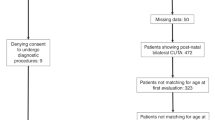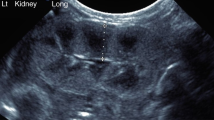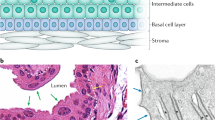Abstract
Objective:
To evaluate outcomes of congenital solitary functioning kidney (SFK) in early childhood.
Study design:
A retrospective study of 32 children diagnosed in utero with SFK owing to unilateral renal agenesis or multicystic dysplastic kidney and followed for 1 to 11.5 years.
Results:
SFK length was in the compensatory hypertrophy range in 45% of fetal sonographic evaluations from mid-pregnancy, and in 85% on postnatal follow-up. Glomerular filtration rate was below normal range in 44.4%, 12.5% and 0% at <1 year, age 1 to 3 years and thereafter, respectively. Hyperfiltration was detected in 18.5% and 82.6% at <1 year and >3 years, respectively. Hypertension was documented in 35% at age 1 to 3 years but in none at an older age. Proteinuria was absent in all children.
Conclusion:
Congenital SFK is apparently associated with little or no renal damage in infancy or childhood. Compensatory enlargement of the functioning kidney begins in utero and might serve as a prognostic indicator for normal renal function after birth.
This is a preview of subscription content, access via your institution
Access options
Subscribe to this journal
Receive 12 print issues and online access
$259.00 per year
only $21.58 per issue
Buy this article
- Purchase on Springer Link
- Instant access to full article PDF
Prices may be subject to local taxes which are calculated during checkout

Similar content being viewed by others
References
Kerecuk L, Schreuder MF, Woolf AS . Renal tract malformations: perspectives for nephrologists. Nat Clin Pract Nephrol 2008; 4: 312–325.
Dias T, Sairam S, Kumarasiri S . Ultrasound diagnosis of fetal renal anomalies. Best Pract Res Clin Obstet Gynecol 2014; 28: 403–415.
Woolf AS, Hillman KA . Unilateral renal agenesis and congenital solitary functioning kidney: developmental, genetic and clinical perspectives. BJU Int 2006; 99: 17–21.
Westland R, Schreuder MF, Ket JC, van Wijk JA . Unilateral renal agenesis: a systematic review on associated anomalies and renal injury. Nephrol Dial Transplant 2013; 28: 1844–1855.
Hains DS, Bates CM, Ingraham S, Schwaderer AL . Management and etiology of the unilateral multicystic dysplastic kidney: a review. Pediatr Nephrol 2009; 24: 233–241.
Schreuder MF, Westland R, van Wijk JAE . Unilateral multicystic dysplatic kidney: a meta-analysis of observational studies on the inicidence associated urinary tract malformations and the contralateral kidney. Nephrol Dial Transplant 2009; 24: 1810–1818.
Desphande C, Hennekam RCM . Genetic syndromes and prenatally detected renal anomalies. Semin Fetal Neonatal Med 2008; 13: 171–180.
Argueso LR, Ritchey ML, Boyle ET Jr, Milliner DS, Bergstralh EJ, Kramer SA et al. Prognosis of patients with unilateral renal agenesis. Pediatr Nephrol 1992; 6: 412–416.
Westland R, Schreuder MF, van Goudoever JB, Sanna-Cherchi S, van Wijk JA . Clinical implications of the solitary functioning kidney. Clin J Am Soc Nephrol 2013; 9: 978–986.
Hegde S, Coulthard MG . Renal agenesis and unilateral nephrectomy: what are the risks of living with a single kidney. Pediatr Nephrol 2009;.24: 439–446.
Vu KH, Van Dyck M, Daniels H, Proesmans W . Renal outcome of children with one functioning kidney from birth. A study of 99 patients and review of literature. Eur J Pediatr 2008; 167: 885–890.
Baudoin P, Provoost AP, Molenaar JC . Renal function up to 50 years after unilateral nephrectomy in childhood. Am J Kidney Dis 1993; 21: 603–611.
Brenner BM, Lawler EL, Mackenzie HS . The hyperfiltration theory: a paradigm shift in nephrology. Kidney Int 1996; 49: 1774–1777.
Sanna-Cherchi S, Ravani P, Corbani V, Parodi S, Haupt R, Piaggio G et al. Renal outcome in patients with congenital anomalies of the kidney and urinary tract. Kidney Int 2009; 76: 528–533.
Westland R, Kurvers RAJ, van Wijk JAE, Schreuder MF . Risk factors for renal injury in children with a solitary functioning kidney. Pediatrics 2013; 131: e478–e485.
Chitty LS, Altman DG . Charts of fetal size: kidney and renal pelvis measurements. Prenat Diagn 2003; 23: 891–897.
Schwartz GJ, Munoz A, Schneider MF, Mak RH, Kaskel F, Warady BA et al. New equations to estimate GFR in children with CKD. J Am Soc Nephrol 2009; 20: 629–637.
National Kidney Foundation. K/DOQI clinical practice guidelines for chronic kidney disease. Evaluation, classification and stratification. Am J Kidney Dis 2002; 39: S56.
National High Blood Pressure Education Program Working Group on High Blood Pressure in Children and Adolescents. The fourth report on the diagnosis, evaluation and treatment of high blood pressure in children and adolescents. Pediatrics 2004; 114: 555–576.
Rosenbaum DM, Korngold E, Teele RL . Sonographic assessment of renal length in normal children. AJR Am J Roentgenol 1984; 142: 467–469.
Van Vuuren SH, Van der Doef R, Cohen-Overbeek TE, Goldschmeding R, Pistorius LR, de Jong TP . Compensatory enlargement of solitary functioning kidney during fetal development. Ultrasound Obstet Gynecol 2012; 40: 665–668.
Cleper R . Mechanisms of compensatory renal growth. Pediatric Endocrinol Rev 2012; 10: 152–163.
Davidson AJ . Uncharted waters: nephrogenesis and renal regeneration in fish and mammals. Pediatr Nephrol 2011; 26: 1435–1443.
Lankadeva YR, Singh RR, Tare M, Moritz KM, Denton KM . Loss of a kidney during fetal life: long-term consequences and lessons. Am J Physiol Renal Physiol 2014; 306: F791–F800.
Bertram JF, Douglas-Denton R, Diouf B, Hughson MD, Hoy WE . Human nephron number: implications for health and disease. Pediatr Nephrol 2011; 26: 1529–1533.
Douglas-Denton R, Moritz KM, Bertram JF, Wintour EM . Compensatory renal growth after unilateral nephrectomy in the ovine fetus. J Am Soc Nephrol 2002; 13: 406–410.
Cho JY, Moon MH, Lee YH, Kim KW, Kim SH . Measurement of compensatory hyperplasia of the contralateral kidney: usefulness for differential diagnosis of fetal unilateral empty renal fossa. Ultrasound Obstet Gynecol 2009; 34: 515–520.
Hill LM, Nowak A, Hartle R, Tush B . Fetal compensatory hypertrophy with unilateral functioning kidney. Ultrasound Obstet Gynecol 2000; 15: 191–193.
Abidari JM, Park KH, Kennedy WA, Shortliffe LD . Serial followup of the contralateral renal size in children with multicystic dysplastic kidney. J Urol 2002; 168: 1821–1825.
Dinkel E, Bitscho J, Dittrich M, Schulte-Wissermann H, Ertel M . Renal growth in patients nephrectomized for Wilms tumor as compared to renal agenesis. Eur J Pediatr 1988;.147: 54–58.
Schreuder MF . Safety in glomerular numbers. Pediatr Nephrol 2012; 27: 1881–1887.
Schreuder MF, Langemeijer ME, Bökenkamp A, Delemarre-Van de Waal HA, Van Wijk JA . Hypertension and microalbuminuria in children with congenital solitary kidney. J Paediatr Child Health 2008; 44: 363–366.
Siomou E, Giapros V, Papadopoulou F, Pavlou M, Fotopoulos A, Siamopoulou A . Growth and function in childhood of a normal solitary kidney from birth or from early infancy. Pediatr Nephrol 2014; 29: 249–256.
Westland R, Schreuder MF, van der Lof DF, Vermeulen A, Dekker-van der Meer IM, Bökenkamp A et al. Ambulatory blood pressure monitoring is recommended in the clinical management of children with a solitary functioning kidney. Pediatr Nephrol 2014; 29: 2205–2211.
Author information
Authors and Affiliations
Corresponding author
Ethics declarations
Competing interests
The authors declare no conflict of interest.
Rights and permissions
About this article
Cite this article
Davidovits, M., Cleper, R., Eizenberg, N. et al. Outcomes of prenatally diagnosed solitary functioning kidney during early life. J Perinatol 37, 1325–1329 (2017). https://doi.org/10.1038/jp.2017.143
Received:
Revised:
Accepted:
Published:
Issue Date:
DOI: https://doi.org/10.1038/jp.2017.143
This article is cited by
-
Glomerular hyperfiltration: part 2—clinical significance in children
Pediatric Nephrology (2023)
-
Is the prognosis of congenital single functioning kidney benign? A population-based study
Pediatric Nephrology (2021)
-
Clinical features of solitary functioning kidney
CEN Case Reports (2018)



